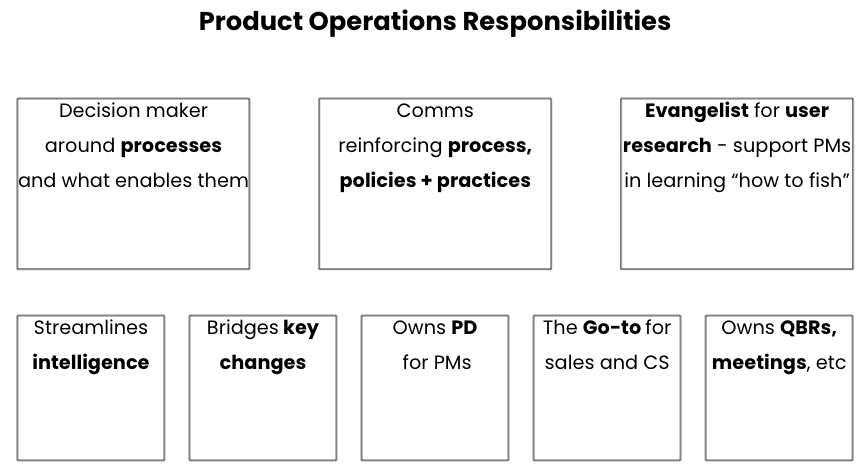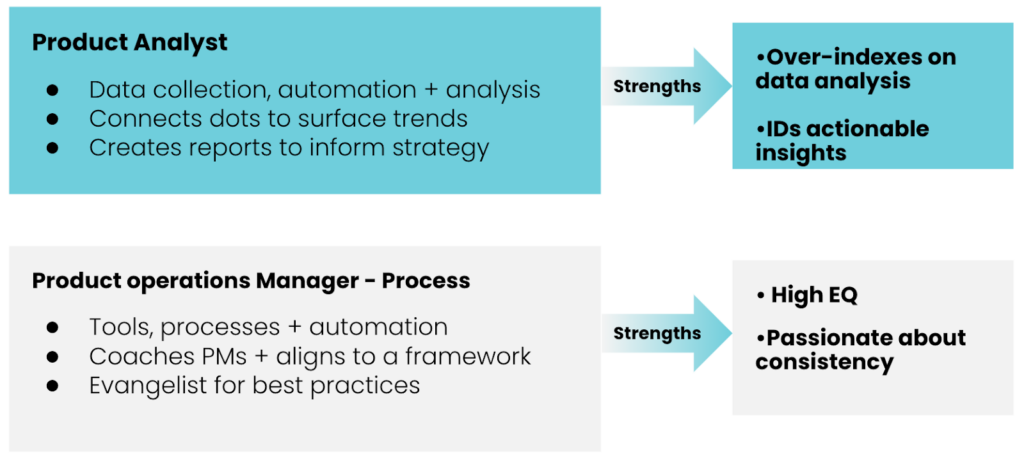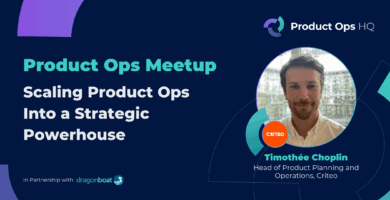Events • On Demand | Watch Time: 48 Min
What is Product Operations and Where Does it Fit Within the Product Organization?
You’ve defined OKRs. Great, now what?
How do you build a plan to achieve your objectives? How can you work cross-functionally to identify the optimal allocation of resources to deliver? What’s the best way to track progress in real-time to ensure you’re on track? All these questions (and more) are often answered by Product Operations.
Recently, we hosted a webinar (see below) in which Denise Tilles, product leader and CPO at Grocket, and Becky Flint, CEO & Founder of Dragonboat, discussed the role product operations plays in helping teams become more outcome-focused. They shared strategies, best practices, specific examples, and advice from their combined 30 years of product experience at companies of all sizes, ranging from early-stage startups to Fortune 1000.
In this post, we’ll share a summary of the webinar in order to answer the question: what is product operations?
The Evolution of Product Management
So, what exactly is product operations and where does it fit into an organization?
Before we answer that, it’s worth taking a look at where it originated. In the earlier days, decision-making was very top-down, with only the top executives and management calling the shots. Over the years, we’ve seen how things have been changing. Product management started out as business analysts who focused more on customer problems and building solutions. In this new era, we see the trend of product managers becoming more strategic and more outcome-driven.

However, these changes don’t come without their share of challenges.
In recent years we’ve seen greater disconnect and a growing decentralization within teams. There’s a gap in the dissemination of information and decision-making. Companies still struggle to connect goals, strategies, and execution. And most importantly, as things change, it’s critical to look at things holistically, which implies thinking of the product itself over individual features and likewise, a product portfolio as a whole over the products.
That’s where product operations comes into play – the golden thread connecting product, engineering, and customer success management.
What is Product Operations?
There are many ways to define product operations, but as Denise mentioned during the webinar, according to Produx Labs, product operations pulls everything together to provide cross-functional visibility and the insights needed to define winning product strategies.
Product operations represents the overlap between product, engineering, and customer success. Its cross functional visibility and insights ensure that teams are getting the right product strategy inputs to propel the business and create customer value.

Let’s take a deeper look at what product operations is, according to Denise Tilles:
Denise’s Three Pillars of Product Operations
Business and Data Insights
Product operations people work with data on everything from engagement to sales, revenue, churn and retention. They also figure out how to collect and analyze that data to be used from strategy creation to monitoring.
Customer and Market Insight
Product operations ask questions like:
- “Are we taking advantage of our touch points with our customers?”
- “How are we facilitating and aggregating all of that research to make sure it’s reusable?”
- “How do we make sure we aren’t hitting the same users every time for inputs?”
Processes and Practices
Last but not least is the strategic side of product operations; they want to determine how to scale the value obtained from product management and make sure it’s done in a consistent way through cross-functional practices and frameworks.
That said, Denise shared the following responsibilities she’s seen from product operations teams:

The 2 Types of Product Operations Roles
The Product Analyst (Data Focused)
A product team might start by hiring a product analyst who is focused on data. This person thinks about how the team is getting its data, the tools it uses, and most importantly, how the team can connect all the dots. Many teams are great at collecting and presenting data, but fall short when it’s time to identify potential trends or insights that could be useful for making better decisions.
A product analyst will develop consistent reporting to inform a product team’s strategy.
Product Operations Manager (Process Focused)
The second type of person in product operations is more engaged in streamlining and improving processes across the product organization. They think about tooling and all of the different processes, i.e, what is annual planning like? How is everyone roadmapping? How does product engage with the different cross functional teams to get their inputs and conduct coaching? To help their teams improve these processes, they must become an evangelist for best practices in the org and keep up-to-date with industry trends.
It’s essential that the product operations manager have a high EQ (emotional intelligence) because they must be able to understand the subtext behind challenges, concerns, and questions, and then understand and address them. Last but not least, this person is passionate about consistency. They geek out on things like processes and templates and showing others how to use them to enable better strategy, revenue, customer value, and put everything together to see the full picture.

As the product organization matures, product operations will also become responsible for OKRs and connecting product strategy to company goals.
Product Management Before and After Product Operations
Product Strategy
Before product operations: Product managers or leaders often create a product strategy based on sales ideas or inputs from a few customers.
After product operations: Product managers have all of that data and key insights coming to them with enablement through automation. This information is easily accessible and it’s no longer a scramble to bring it all together. Better strategy planning helps enable product teams to focus on customer value and business outcomes.
User Testing
Before product operations: Teams may say something like, “Oh yeah, we do user testing. We share the release a week before we send it out.” But, whether or not they get good or bad feedback, they still release the increment.
After product operations: Product ops will help put good practices and processes in place so that the team’s building, discovering, and prototyping like business as usual. They’ll even create templates around user testing as well.
OKRs
Before product operations: Product teams’ OKRs end up as a list of to-dos that are forgotten in a Google Sheet. Their manager looks at it, but they don’t go back to it.
After product operations:
OKRs are tied to product initiatives and help guide innovation and creativity while driving both customer and business value. Product Ops helps to define OKRs, prioritize product initiatives, estimate effort and allocate resources, track progress and adjust as needed, and share with stakeholders. Now the organization is focused on outcomes over outputs.
To facilitate this, product ops implements a responsive product portfolio tool to guide the process, establish best practices for the entire teams, and rally all stakeholders in achieving the OKRs for the teams and company.
Read more about connecting OKRs with product initiatives.
Roadmapping
Before product operations: Product managers have their own format for roadmapping, and they create their roadmaps around features (outputs) instead of outcomes.
After product operations: There’s one person looking at the product portfolio holistically, even for teams of 90 product managers, figuring out how to focus toward outcomes. A roadmap template exists that is very focused on outcomes and customer value versus features. Cross functional teams are thrilled with the consistency, everyone knows how the process works, and they don’t have to deal with as much context-switching when they work with different teams.
Getting Started with Product Operations
Typically, the successful implementation of any new function or practice depends on buy-in, and not only from management, but cross-functional teams as well. Some may ask, “How does prod ops differ from marketing ops, sales ops, and DevOps?” Well, the truth is, yes, they are all operational roles and they can work together. It’s important to make sure everyone is intentional and purposeful regarding who is responsible for what, but the good thing is that the ops roles can benefit one another. For example, product operations can share engagement numbers with the sales ops manager, forming a collaborative process.
When it comes to who to hire and how, each company has its own unique needs with different demands and complexity. Most companies initially hire for their most pressing need, (as opposed to hiring a whole team) and then build the function out from there. Take the time to analyze your team’s challenges and current state. What’s lacking?
Along with that, don’t forget to create a consensus with your team about where it wants to get started with product operations. Decide which area is most important to address first and then start creating the job description. Look at other companies’ job descriptions for inspiration and evaluate what’s important to you. There’s no cookie-cutter job description for product operations because processes and templates at one company may be very, very different from the next, but it can help jumpstart the process.
Last but not least, creating a product operations team is a challenge because they aren’t revenue-generating. To overcome this, make sure to be able to tie their outcomes and deliverables towards greater customer value. At the end of the day, better business outcomes equal more revenue.
Check out more from Denise Tilles!

Featured Speakers

Becky Flint
Founder and CEO of Dragonboat
Becky is a product and tech executive based in the Silicon Valley. She has built and scaled product and engineering teams globally for both startups and Fortune 500 companies. Currently Becky is the Founder and CEO of Dragonboat with a mission to empower responsive leaders and their teams to build better products faster. Prior to founding Dragonboat, Becky has held executive roles at Feedzai, Bigcommerce, Tinyprints/Shutterfly, and PayPal.

Denise Tilles
CPO, Grocket


